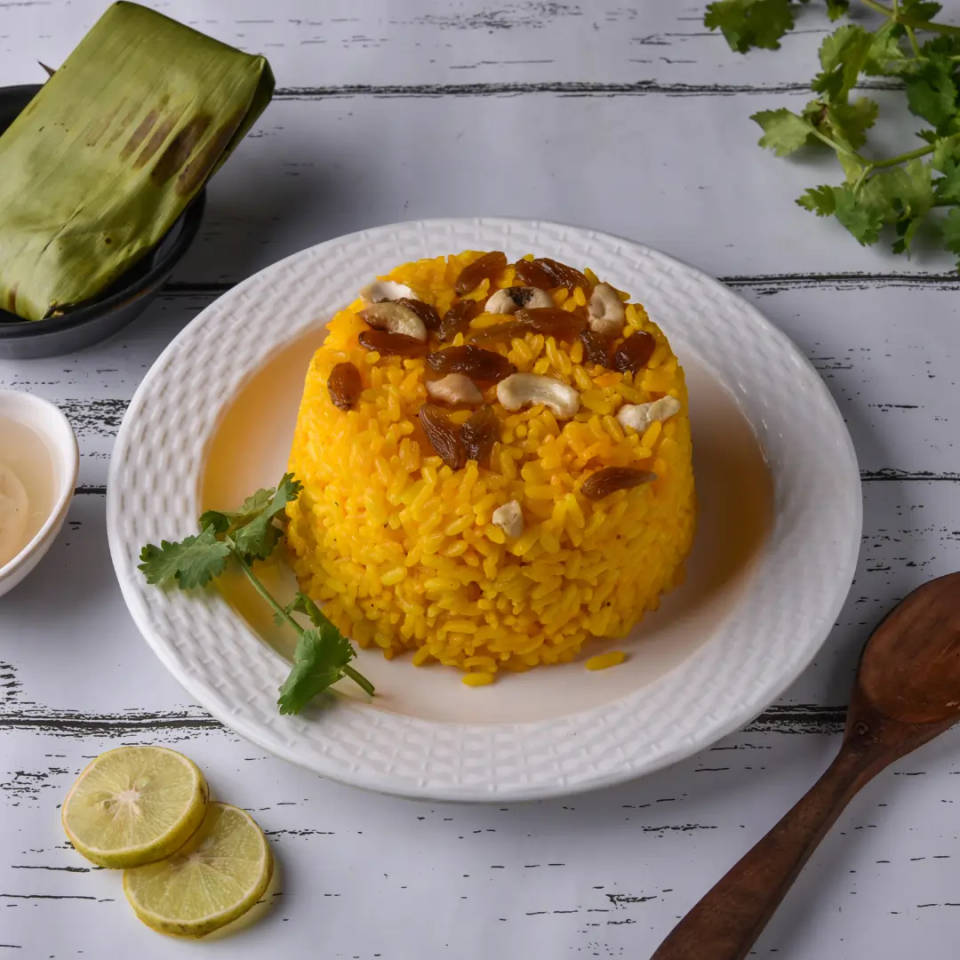- 1
Basanti Pulao is a flavoured and aromatic rice dish, deeply rooted in the rich culinary traditions of Bengal, India.
- 2
It displays a appetizing yellow colour and comes with delightful flavours.
- 3
Such a pulao is sure to accompany various dishes or become a comfortable meal to have on its own.
- 4
So, first of all, take 1 cup of the main ingredient-rice.
- 5
Basmati rice is generally steamed for its long grains and fragrant aroma to make any pulao.
- 6
The excess starch present in the rice has to be washed off while rinsing under running water. It is suggested that the rice is soaked in water for nearly about 30 minutes to help the grains cook evenly.
- 7
Meanwhile, get ready other ingredients to make a highly aromatic base.
- 8
In a deep-bottomed pan, heat 1 tablespoon ghee and 2 tablespoons of oil over medium heat.
- 9
This much ghee and oil will prevent the rice from sticking in that pan, apart from giving it this rich texture.
- 10
When the ghee and oil are hot, add 1 bay leaf, 4 cardamom pods, 5 cloves, and a 1-inch piece of cinnamon.
- 11
Dry roast these whole spices on the pan for a minute or two to allow their essential oils to soak into the oil and form an aromatic base for the pulao.
- 12
Now, add 1 teaspoon of ginger paste to the pan, and mix it so that there is a homogenous paste in the pan. It goes quite well to provide you with a nice, warm, earthy flavour. It adds zest and warmth to this dish in general.
- 13
Sprinkle in 1/2 teaspoon of turmeric powder while saut ing the ginger and garlic.
- 14
That gives the pulao its characteristic golden hue. While it helps to colour, its earthy note is subtle and balances out all the sweetness from the other ingredients.
- 15
Now, add the soaked and drained rice to the pan with the well-mixed spice-ginger mixture.
- 16
Mix the rice and spices over carefully so that all the grains are well coated by the fragrant oil and turmeric.
- 17
This step is important because it lets the flavours mingle and infuse into the rice while cooking. Add ¾ teaspoon salt and 2 cups of water to the pot.
- 18
Mix gently, then bring to a boil.
- 19
When it starts boiling reduce the flame to a minimum and close the pan with a lid. Let it cook in that way for around 15-20 minutes or till water is completely absorbed and the rice becomes soft.
- 20
In the final minutes of cooking, you can add slit green chillies to give a spicy taste. The chillies provide a subtle spiciness to the pulao, increasing the intensity of the general flavouring.
- 21
Meanwhile, add chillies and cashews browned in just a little oil.
- 22
These become crunchy and nutty but add massive value to the dish.
- 23
Add 2 tablespoons raisins to the pan and fry until they inflate and a hint of sweetness appears amid the spices. Stir the cooked rice with a fork but be careful not to break the grains.
- 24
Add the cashews and raisins that were fried and the remaining 1/2 teaspoon of garam masala to this step.
- 25
A sweet twist is gotten by sprinkling sugar over the rice and mixing it lightly.
- 26
This sugar balances the spices, brings out a unique flavour profile, and makes it look distinct altogether. Serve it hot garnished with more cashews and raisins as preferred.
- 27
This colourful rice dish, flavoured so aromatic, will go very well with festive occasions or family get-togethers offering a real taste of Bengali cuisine, comforting yet delightful to share with every bite and relish the perfect balance of spices, sweetness, and richness which gives Basanti Pulao a darling dish in all Indian households.

 Serves 4
Serves 4 30 mins
30 mins 396 Kcal
396 Kcal